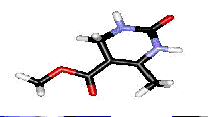
Ab initio (RHF and MP2) and density functional (B3LYP) calculations with basis sets ranging from 3-21G(*) up to 6-31+G** on dihydropyrimidine-5-carboxylates 4 are performed. At all levels of theory a slight preference (1 kcalmol/mol) for a cis ester orientation (4a) is found, as proposed for the receptor bound geometry in biologically active dihydropyrimidine derivatives. For the ring conformation a strong dependence on the computational procedure is observed. Calculations with basis sets lacking polarization functions on first row heavy atoms (3-21G(*), 6-31G, 6-311G) lead to planar ring geometries. Inclusion of polarization functions yields puckered boat conformations. The puckering amplitudes increase in the order Q(RHF) < Q(B3LYP) < Q(MP2). With MP2 unrealistically strong deviations from planarity are predicted. By single-crystal X-ray analysis an almost planar ring conformation is found. Energy differences between planar and puckered geometries are negligible with RHF and B3LYP (< 1 kcal/mol), whereas with MP2 somewhat larger E values (1.5 - 2.6 kcal/mol) are calculated, especially when diffuse functions are included.
